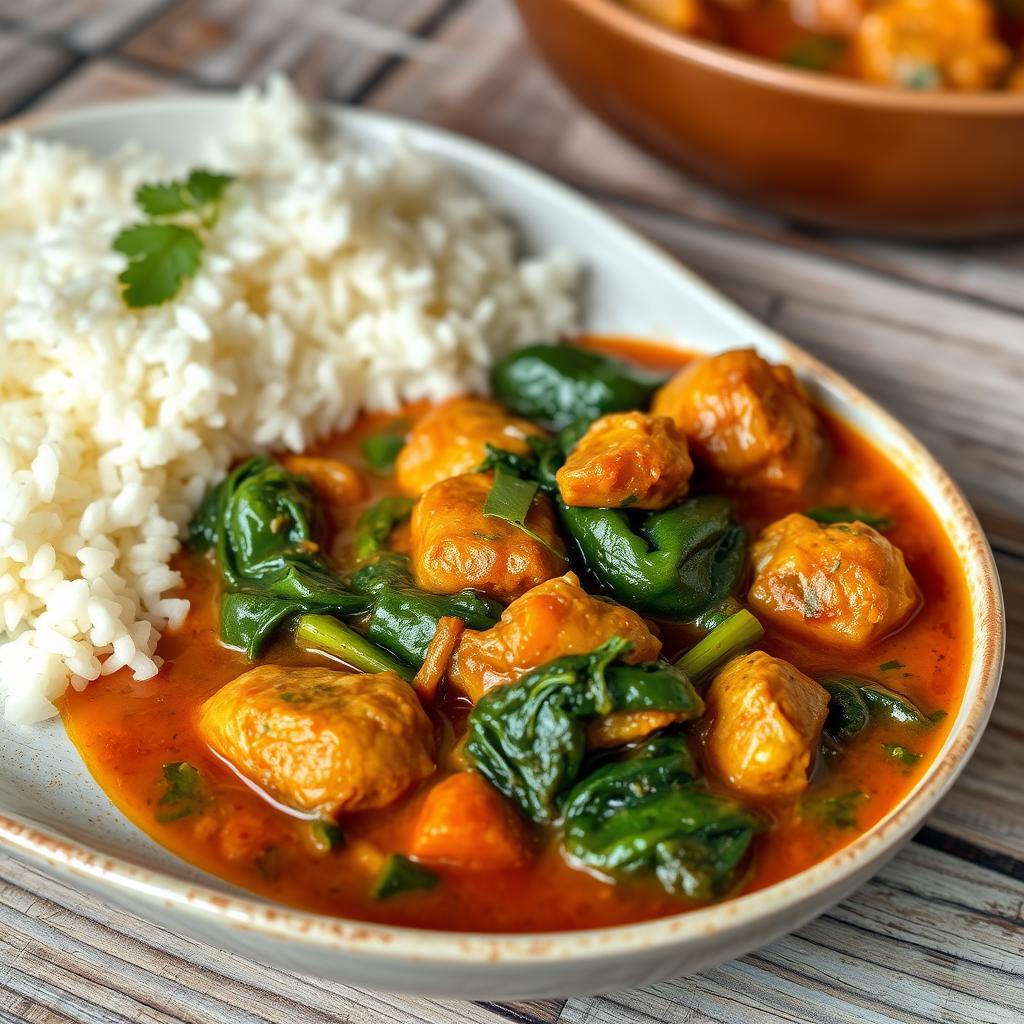“`html
9 Steps to Make Delicious African Spinach Stew at Home
Dive into the heart of West African cuisine with this incredibly flavourful and nourishing African Spinach Stew, often known as Efo Riro (in Yoruba) or simply vegetable stew depending on the region. This dish is a vibrant medley of tender spinach simmered in a rich, savory sauce packed with tomatoes, peppers, onions, and often enriched with various meats or fish and traditional seasonings like crayfish. It’s more than just a meal; it’s a comforting embrace, a celebration of fresh produce and bold flavours that grace dining tables across countries like Nigeria and Ghana. This stew is versatile, healthy, and surprisingly easy to make right in your own kitchen. In this recipe, I’ll guide you step-by-step to create an authentic-tasting African Spinach Stew that will impress your family and friends. Get ready to explore the deliciousness of African cooking!
Quick Information Table
| Metric | Value |
|---|---|
| Prep Time: | 25 minutes |
| Cook Time: | 40 minutes |
| Total Time: | 1 hour 5 minutes |
| Difficulty Level: | Medium |
| Servings: | 4-6 |
| Calories: | Approx. 350-450 kcal per serving (varies with protein/oil) |
Ingredients You’ll Need
For the Stew Base:
- 3 tablespoons Palm Oil (or Vegetable Oil)
- 1 large Onion, chopped
- 2 Red Bell Peppers, roughly chopped
- 1-2 Scotch Bonnet Peppers (or Habanero), seeds removed for less heat, chopped (optional)
- 4 ripe Plum Tomatoes, roughly chopped (or 1 can, 14.5 oz / 400g, chopped tomatoes)
- 1 tablespoon Tomato Paste (optional, for deeper colour/flavour)
- 2 cloves Garlic, minced (optional)
- 1-inch Ginger, grated (optional)
For the Protein & Flavour:
- 1 lb (approx. 450g) Assorted Meats (e.g., beef, goat meat, shaki/tripe, smoked turkey), cooked and cut into bite-sized pieces
- OR 1 lb (approx. 450g) Fish (e.g., mackerel, tilapia), cleaned and cut (can be fried or smoked)
- 1/4 cup Dried Shrimp, rinsed (optional)
- 1/4 cup ground Crayfish
- 2 Bouillon Cubes (Maggi or Knorr preferred), crumbled
- 1 cup Meat or Vegetable Stock (or water)
- Salt and Black Pepper to taste
For the Spinach:
- 2 lbs (approx. 900g) Fresh Spinach, washed and roughly chopped
- OR 2 packs (16 oz / 450g each) Frozen Chopped Spinach, thawed and squeezed dry
Equipment Needed
- Large Pot or Dutch Oven
- Blender or Food Processor (optional, for a smoother base)
- Knife and Cutting Board
- Wooden Spoon or Spatula
Step-by-Step Instructions
- Prepare the Pepper Base: If using a blender for a smoother sauce, blend the chopped red bell peppers, tomatoes, and scotch bonnet peppers until mostly smooth but still slightly textured. If not blending, ensure they are finely chopped. Set aside. Chop the onion separately.
- Sauté Aromatics: Heat the palm oil (or vegetable oil) in your large pot over medium heat. Once hot, add the chopped onions and sauté until softened and translucent, about 5-7 minutes. If using garlic and ginger, add them now and cook for another minute until fragrant.
- Cook the Pepper Base: Pour the blended pepper mixture (or add the finely chopped peppers and tomatoes) into the pot. Add the tomato paste, if using. Stir well and cook, stirring occasionally, for about 10-15 minutes, allowing the mixture to reduce and thicken, and the oil to start separating. This step cooks out the raw taste of the peppers and tomatoes.
- Add Protein and Flavour Enhancers: Introduce your pre-cooked assorted meats or fish to the pot. Add the rinsed dried shrimp (if using), ground crayfish, and crumbled bouillon cubes. Stir everything together thoroughly.
- Simmer the Base: Pour in the meat/vegetable stock or water. Stir well, bring the mixture to a gentle simmer, then reduce the heat to low, cover the pot, and let it cook for 10-15 minutes. This allows the flavours to meld beautifully.
- Introduce the Spinach: Add the washed and chopped fresh spinach to the pot. If using a large amount, you might need to add it in batches, stirring after each addition to allow it to wilt down slightly. If using thawed frozen spinach (squeezed dry), add it all at once.
- Combine and Cook Spinach: Gently stir the spinach into the sauce until it’s well combined. Be careful not to over-stir. Allow the spinach to cook down and wilt completely, which should take about 5-7 minutes. Avoid overcooking to retain some texture and nutrients.
- Taste and Adjust Seasoning: Taste the stew and adjust the seasoning as needed with salt and black pepper. If it needs more depth, you can add a little more crayfish powder or half a bouillon cube.
- Final Simmer: Let the stew simmer uncovered for a final 2-3 minutes to ensure everything is heated through and the flavours are perfectly blended. Take it off the heat.
Pro Tips for Success
- Spinach Handling: For fresh spinach, wash it thoroughly to remove any grit. Don’t cook it for too long; it should wilt but retain some vibrant green colour and bite. If using frozen, thawing and squeezing out *all* excess water is crucial to prevent a watery stew.
- Palm Oil Balance: Authentic African Spinach Stew often uses palm oil for its distinct flavour and colour. If the taste is too strong for you, use half palm oil and half vegetable oil, or just use vegetable oil entirely.
- Flavour Depth: Don’t skip the crayfish powder and smoked/dried shrimp if possible; they add an irreplaceable umami depth characteristic of many West African dishes. Find crayfish powder at African or international markets, or online.
- Spice Control: Scotch bonnet peppers add significant heat. Control the spice by removing the seeds and membrane, using only half a pepper, or omitting it altogether if you prefer a mild stew.
- Make Ahead & Storage: Like many stews, African Spinach Stew often tastes even better the next day! Store leftovers in an airtight container in the refrigerator for up to 3-4 days. It also freezes well for up to 3 months.
How to Serve and Present
African Spinach Stew is traditionally served hot as a main course, accompanied by a starchy side. Popular pairings include:
- Swallows: Pounded Yam, Fufu (cassava or plantain), Eba (made from garri), Amala.
- Grains: Plain Boiled White Rice, especially long-grain parboiled rice.
- Tubers: Boiled Yams or Boiled/Fried Plantains.
For presentation, ladle a generous portion of the stew into a bowl or onto a plate alongside the chosen accompaniment. You can garnish with a few slices of fresh onion or bell pepper for a pop of colour and freshness. Ensure there’s a good ratio of sauce, spinach, and protein in each serving.
Variations to Try
- Vegetarian/Vegan Delight: Omit all meat, fish, crayfish, and dried shrimp. Use vegetable stock. Add chunks of firm tofu, mushrooms, or chickpeas for protein and substance. Ensure your bouillon cubes are vegetable-based.
- Efo Riro Style (with Egusi): For a thicker, nuttier version popular in Nigeria, whisk about 1/2 cup of ground egusi (melon seeds) with a little water to form a paste. Add it to the stew base (after cooking down the peppers, before adding stock) and cook for a few minutes, stirring, before proceeding with adding protein and spinach.
- Leafy Green Swap: If spinach isn’t available, you can substitute other robust leafy greens like kale (remove tough stems and cook slightly longer), collard greens (chop finely and cook longer), or Swiss chard.
FAQ Section
- Q: What exactly is ground crayfish? Can I substitute it?
A: Ground crayfish is dried, milled crayfish (small shrimp/prawns) used extensively in West African cooking for its unique savory, umami flavour. It’s hard to substitute perfectly. Some suggest a tiny amount of shrimp paste or fish sauce, but it will alter the taste. If unavailable, you might have to omit it, but the authentic flavour will be impacted. - Q: Do I have to use Palm Oil?
A: No, you don’t have to. Palm oil provides a traditional flavour and reddish hue, but good quality vegetable oil, canola oil, or even coconut oil can be used as substitutes if you prefer or cannot find palm oil. - Q: Can I use frozen spinach instead of fresh?
A: Absolutely! Frozen chopped spinach works very well. The key is to thaw it completely and thoroughly squeeze out as much excess water as possible before adding it to the pot. This prevents the stew from becoming watery. Use approximately two 16oz (450g) packages. - Q: My stew seems too oily. What can I do?
A: You can carefully skim off some excess oil from the surface using a spoon once the stew is cooked. For next time, simply start with less oil. Palm oil, in particular, can be quite rich. - Q: What kind of meat or fish is best?
A: This stew is incredibly versatile! Popular choices include beef, goat meat, chicken, turkey (especially smoked turkey wings), and assorted meats like tripe (shaki) and cow skin (ponmo). For fish, smoked mackerel, fresh tilapia, or catfish are common. Using a mix (like beef and smoked fish) adds complexity.
Conclusion
Making African Spinach Stew at home is a rewarding experience that brings the vibrant flavours of West Africa to your table. With its rich sauce, tender greens, and hearty protein, it’s a complete meal that’s both comforting and nutritious. Follow these steps, use the tips provided, and don’t be afraid to adjust the spice or ingredients to your liking.
Now it’s your turn to create this delicious stew! Give this recipe a try and let me know how it turns out. Share your results and any variations you tried in the comments below! If you enjoyed this recipe, you might also like trying your hand at Authentic Nigerian Jollof Rice or flavourful Suya Skewers. Happy cooking!
“`

